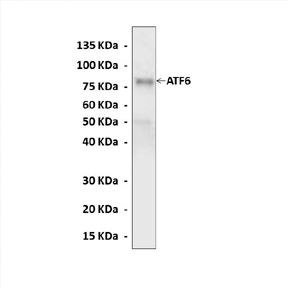Anti-ATF6: Rabbit Activating Transcription Factor 6 Antibody |
 |
BACKGROUND Activating transcription factor 6 (ATF6) is an endoplasmic reticulum (ER) stress-regulated transmembrane transcription factor that activates the transcription of ER molecules ATF6 consists of the two closely related ATF6alpha and ATF6beta in mammalian cells. They are synthesized as type II transmembrane proteins in the ER, designated pATF6alpha (P) and pATF6beta(P). ER homeostasis can be perturbed by up-regulation of secretory proteins or by disruption of protein processing, a condition termed ER stress. ER stress causes increased protein misfolding and leads to activation of the unfolded protein response (UPR), an evolutionarily conserved pathway to alleviate ER stress.1 The UPR leads to a slowdown in protein synthesis, an upregulation of ER chaperones, and an upregulation of ER-associated protein degradation. The three effector proteins for the UPR are IRE1, PERK, and ATF6. During the UPR, IRE and PERK remain in the ER and act via cytoplasmic effectors, whereas ATF6 is transported to the Golgi complex. These precursor forms relocate to the Golgi apparatus via COP II vesicles, where they are cleaved by sequential action of site-1 and site-2 proteases. The ATF6alpha/beta N-terminal fragments released from the membrane, designated pATF6alpha (N) and pATF6beta(N), enter the nucleus and activate transcription of their target genes, because they contain all domains necessary for an active transcription factor. They contain a bZIP motif that binds DNA at ER stress response elements that control expression of the ER chaperones BiP (GRP78) and GRP94.2
Transport of ATF6 and other cargo proteins likely involves the COPII coat, a complex of five cytoplasmic proteins that selects cargo at the ER membrane and pinches off membranes to form vesicles. The five proteins are the GTPase Sar1, which is recruited to the ER membrane and initiates coat formation by GDP to GTP exchange; the heterodimeric complex Sec23/Sec24, which binds to Sar1•GTP; and a second dimeric complex, Sec13/Sec31, which binds to Sec23/24 and provides the curvature necessary for vesicle fission. Cargo is selected by interactions between domains on the Sec24 subunit and cytoplasmic motifs on cargo proteins. Inhibition of COPII by overexpression of dominant negative Sar1 has been shown to block transport of ATF6. A sorting signal may be provided by a cargo receptor that engages ATF6 in the ER lumen and COPII in the cytoplasm, an interaction occurring specifically during stress.3
Transport of ATF6 and other cargo proteins likely involves the COPII coat, a complex of five cytoplasmic proteins that selects cargo at the ER membrane and pinches off membranes to form vesicles. The five proteins are the GTPase Sar1, which is recruited to the ER membrane and initiates coat formation by GDP to GTP exchange; the heterodimeric complex Sec23/Sec24, which binds to Sar1•GTP; and a second dimeric complex, Sec13/Sec31, which binds to Sec23/24 and provides the curvature necessary for vesicle fission. Cargo is selected by interactions between domains on the Sec24 subunit and cytoplasmic motifs on cargo proteins. Inhibition of COPII by overexpression of dominant negative Sar1 has been shown to block transport of ATF6. A sorting signal may be provided by a cargo receptor that engages ATF6 in the ER lumen and COPII in the cytoplasm, an interaction occurring specifically during stress.3
REFERENCES
1. Brown, M.S. et al: Cell 100:391-8, 2000
2. Shen, J. & Prywes, R.: Methods 35:382-9, 2005
3. Benjamin, I.J.: Circul. Res. 98:1120-2, 2006
2. Shen, J. & Prywes, R.: Methods 35:382-9, 2005
3. Benjamin, I.J.: Circul. Res. 98:1120-2, 2006
Products are for research use only. They are not intended for human, animal, or diagnostic applications.
Параметры
Cat.No.: | CA1011 |
Antigen: | Short peptide from human ATF6 C-terminal sequence. |
Isotype: | Rabbit IgG |
Species & predicted species cross- reactivity ( ): | Human, Rat |
Applications & Suggested starting dilutions:* | WB 1:1000 IP n/d IHC n/d ICC n/d FACS n/d |
Predicted Molecular Weight of protein: | 78 kDa |
Specificity/Sensitivity: | Detects endogenous levels of ATF6 proteins without cross-reactivity with other family members. |
Storage: | Store at -20°C, 4°C for frequent use. Avoid repeated freeze-thaw cycles. |
*Optimal working dilutions must be determined by end user.
Документы
Информация представлена исключительно в ознакомительных целях и ни при каких условиях не является публичной офертой








